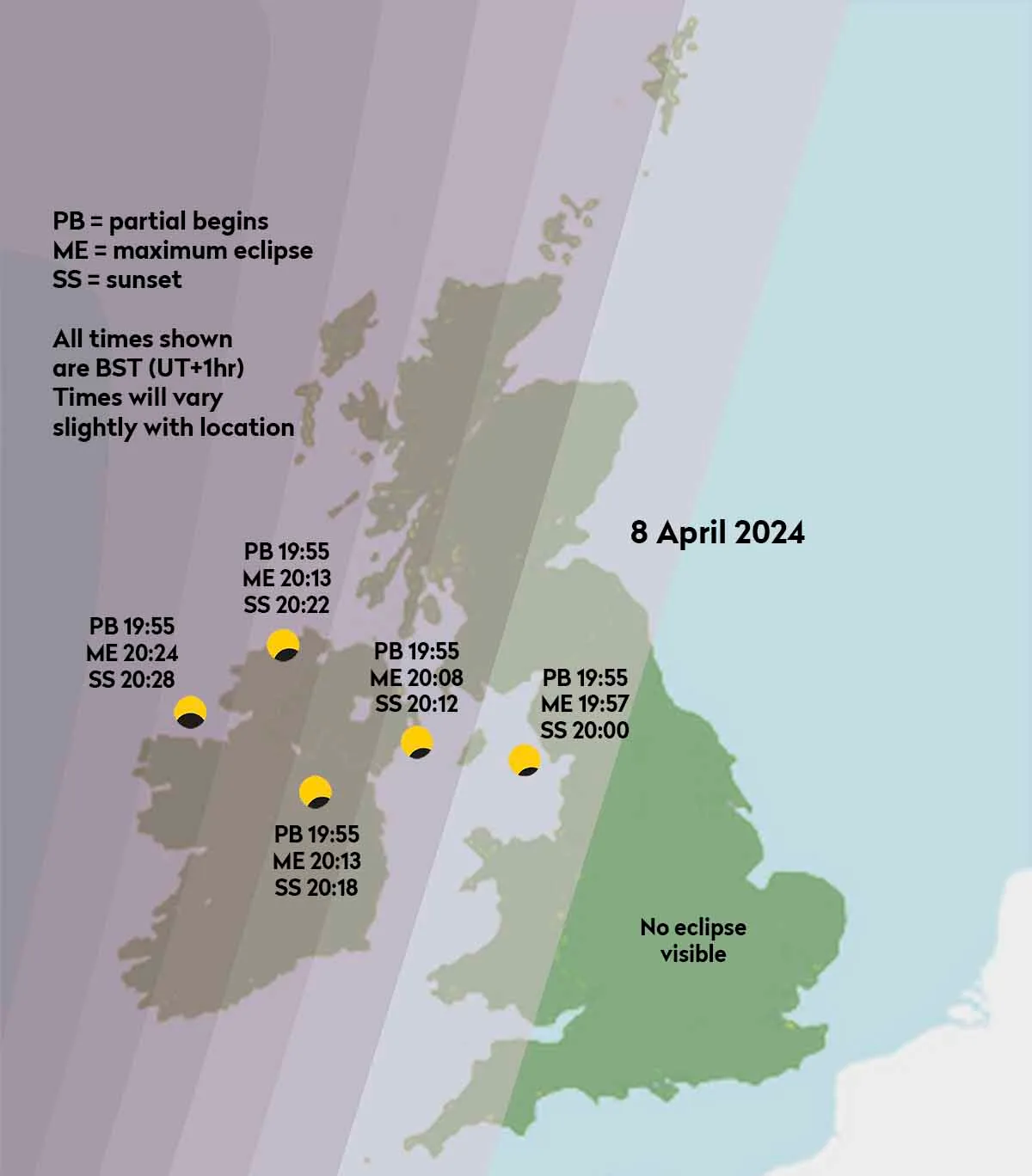The next solar eclipse visible from the UK is a good one: a decent partial solar eclipse visible across the whole of the UK and Ireland, at 10am on Saturday 29 March 2025.
If you're in the UK and you're waiting for a total solar eclipse to come to you, you'll need saint-like patience.
Totality will next visit the British Isles on 23 September 2090.
But before this decade is out the Sun will be partially eclipsed no fewer than seven times as seen from the UK, with the biggest being a whopping 96%.
Here’s everything you need to know about upcoming UK solar eclipses for the rest of the decade.
For more advice, read our guide to find out when the next eclipse is taking place or visit NASA's spectacularly detailed eclipse website for maps and timings
8 April 2024 - Northern Ireland, Scotland, Wales, Lake District, Lancaster

Mexico, the USA and Canada are getting very excited about the April 8 total solar eclipse, which brings up to 4 minutes 28 seconds of totality.
That makes it the longest on land since 2010.
However, the UK does get a look in, of sorts, during the April 8 2024 eclipse’s very final moments.
From Northern Ireland and the west coasts of Scotland and Wales, as well as from the Lake District and Lancaster, a partial solar eclipse will begin on 8 April 2024 just as the Sun is setting.
Observers need to be as far south and west as possible to see anything, with a flat ocean horizon (and clear skies) critical.

From north-west Scotland, the horns of a partially eclipsed Sun will set, as this simulation shows.
From the North Atlantic, it will be technically possible to see a totally eclipse sunset.
That’s a bucket-list view for even very experienced eclipse-chasers and it’s precisely what may be seen by cruisers on the Fred Olsen Cruise Lines’ Bolette, which will divert from its route from Southampton to the Azores to intercept the path of totality just as the moon’s shadow leaves Earth.
That could be a spectacular prelude to some more sure-fire partial solar eclipses from the UK mainland in the late-2020s.
For more info, read our guide on observing the April 8 solar eclipse from UK and Ireland.
29 March 2025 - partial eclipse across all of the UK

Next comes a partial solar eclipse that’s almost a total.
From Hudson Bay in a remote part of northern Quebec, Canada, as much as 94% of the Sun will be eclipsed.
Those looking for good upcoming UK solar eclipses should take note.
From the UK the 29 March 2025 partial solar eclipse will still be significant, with the Outer Hebrides seeing about 47%, Northern Ireland 44% and West Wales 38%.
In London, about 30% of the Sun will be eclipsed by the Moon on 29 March 2025.
This mid-morning event with the eclipse about 40º up in the southeast at the peak, however, is destined to be overshadowed.
12 August 2026 - partial eclipse across all of UK

Europe’s first total solar eclipse since 1999 will bring up to 2 minutes and 18 seconds of totality to Iceland and Spain on 12 August 2026, with a totally eclipsed sunset visible from Ibiza, Mallorca and Menorca).
The path of totality for the 12 August 2026 solar eclipse cruelly misses the British Isles by a few hundred miles.
Those who can’t travel will be treated to a huge partial solar eclipse just before sunset peaking at 96% in the Scilly Isles.
Everywhere in the UK will see at least an 89% partially eclipsed Sun on 12 August 2026, about 13º above the northwestern horizon.
This is probably one of the best UK solar eclipses happening this decade.
2 August 2027 - partial eclipse across all of UK

An entire lunar year later another solar eclipse occurs.
This time it’s the big one, with a total solar eclipse across the Straits of Gibraltar, North Africa and the Arabian Peninsula bringing as much as 6 minutes 23 seconds of totality.
That will occur over Luxor, Egypt in the longest totality of the century, with Mecca in Saudi Arabia also in the path of totality.
From the UK it’s again the Scilly Isles that see most of the partial eclipse at 48%, reducing to 13% for the Shetland Isles.
Londoners get 42%.
The eclipse will peak around 10:00 a.m. as the Sun and Moon are around 37° above the eastern horizon.
26 January 2028 - partial eclipse across all of UK

The 26 January 2028 eclipse is arguably the most exciting of all UK solar eclipses this decade, but being furthest west will help.
On 26 January the prize is a partially eclipsed sunset above the southwestern horizon.
The best places to be include Northern Ireland (42%), West Wales (51%) and Cornwall (55%).
Further afield this is an annular solar eclipse, where the apparent size of the new Moon isn’t quite large enough to cover the Sun.
The ‘ring of fire’ eclipse on 26 January 2028 will be seen from within a mostly seaborne path that begins in the Galápagos Islands in the Pacific Ocean and ends in southern Spain and the Balearic Islands.
A ‘ring of fire’ sunset will be seen from Ibiza and Mallorca.
12 June 2029 - partial eclipse across eastern Scotland, northeast England

A slight 34% partial solar eclipse will be visible in Iceland, Greenland, Scandinavia, northern Canada, Alaska and Siberia. The U.K. gets a slight glimpse of this one.
Like in 2024, it’s a slight view, only those on the eastern coast of Scotland and northeast England in position for a 19% eclipse sunrise.
Even from the Shetland Islands, it will be only 2º above the northeastern horizon.
1 June, 2030 - partial eclipse across all of UK

Another annular solar eclipse, this visible from within a path from Algeria to Japan, brings a sunrise partial solar eclipse to the UK
From all locations the eclipse will begin as, or just after, the Sun rises in the east, with as much as 49% being obscured as it hangs 12º above the southeastern horizon.
On 1 June 2030, southeast England will see the most significant eclipse.
The UK may not be the best place in the world to hang out waiting for a total solar eclipse.
But British eclipse-chasers can look forward to a few enticing sights from home in the 2020s with some tempting opportunities for short-haul eclipse-chasing.
If you observe or photograph an eclipse in the UK, share your images and experiences with us by emailing contactus@skyatnightmagazine.com



